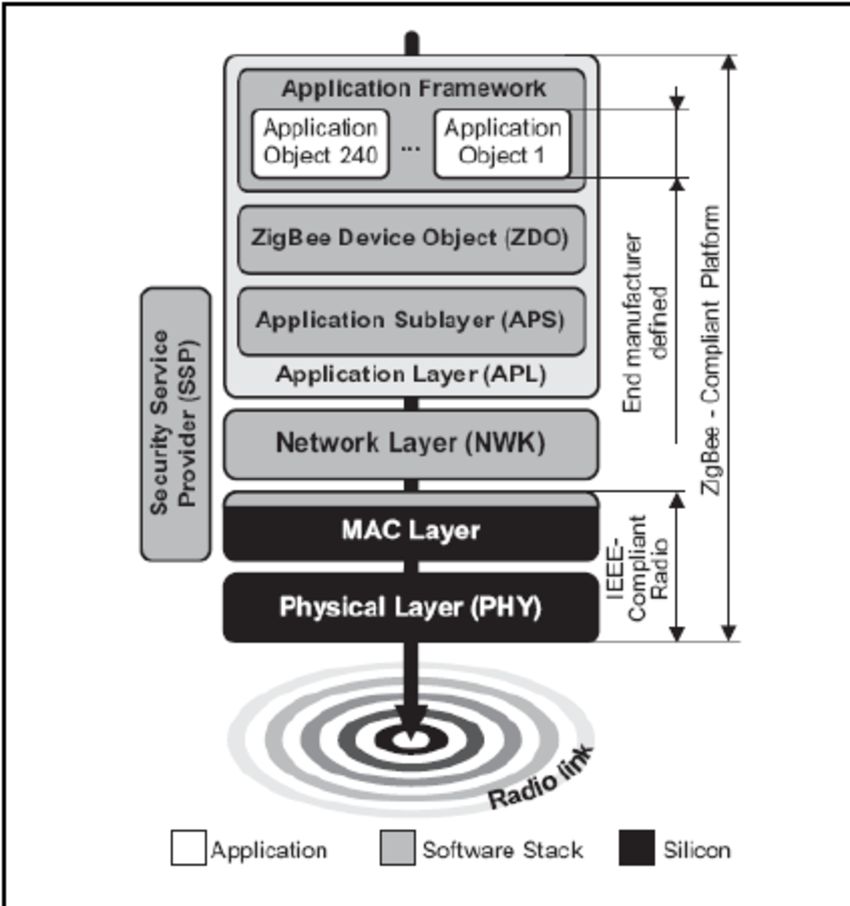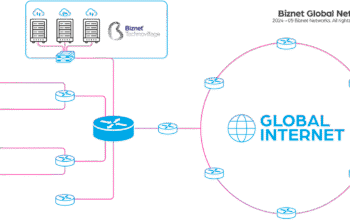Warganet – Zigbee is the only full lot solution-from network networks to common languages that allow smart items to work together.
ZigBee certified products connect and communicate with each other using the same IoT language, and millions of Zigbee products that are already deployed in smart homes and commercial buildings today. ZigBee builds forward compatibility. Improve user and developer selection and flexibility, and is confident that products and services work together through all layers of standardization and test piles.
Zigbee Technology Architecture
Four certification programs make it easy for you to get your product certification and show interoperability with your respective certified products.
Zigbee. Introduction Architecture Node Types Network Topologies Traffic Modes Frame Format Applications Conclusion Topics.
Optimized for low power consumption to extend battery life and simple do-it-yourself use for consumers and commercial spaces.
Self-organized mesh topology can be scaled for thousands of knots and proven with nearly ten years of improvement and real-world applications.
AS-128-bit message encryption and authentication, secure personal data for elliptical certificates and encryption, and device authentication from adjacent networks.
Freedom to choose equipment and suppliers. The rich data model provides a common language for devices that can work together regardless of the brand.
Deep Dive Into Zigbee For Home Automation
It allows users to interact smoothly with their Zigbee network using a smartphone, tablet or other device that allows Bluetooth.
Zigbee is a complete, secure, reliable and market-proven solution used by most smart home ecosystem suppliers such as Amazon’s Echo Plus, Samsung Smartthings, Simplification (Philips Hue) and more. Zigbee products can be used with any ZigBee Certified Connected home platform or business, so you can choose which products you can serve.
Zigbee excels in commercial building facilities, focusing heavily on energy efficiency, true grid networks, enterprise network size and an impressive range of communications. Owners, operators and tenants benefit greatly from added savings and ensure minimum life cycle costs with this bright, easy-to-install wireless network.

The world’s leading utilities, power service providers, product manufacturers and technology companies use ZigBee. Zigbee standards provide innovative solutions for smart meters and home area networks (HANS), which allow consumers to understand and control their energy use by connecting them to the smart grid. The UK government has chosen ZigBee Smart Energy as a mesh network for connecting devices in a public network for its robustness, security and ability to provide 2.4 GHz and SUB band connections -Ghz.
Wireless Body Area Networks For Healthcare Applications: Protocol Stack Review
Zigbee is a strong low -risk technology with a diverse global supply chain, including many zigbee -compliant platforms. Most importantly, this means that your ZigBee products will enter the huge ZigBee equipment market. Interoperability embedded in the application layer means that your product will be used with any other ZigBee certified product, which gives you a large addressable market with one product implementation.
Companies from startups to major brands have developed interoperable zigbee products in each category of devices. Choose a product that suits you and your customers without one-off integration costs or supplier lock-in.
You can buy ZigBee Certified Products that because they are built on open global standards and will be used with any Zigbee Smart Home or a business platform you use sooner or later. Zigbee certification means you can choose products that continue to work for you and not lock in the single supplier ecosystem. About 12, 2023 industry 5.0, IoT, IoT devices, Smart City, Smart City, Smart Healthcare, Smart Home, Smart Home, Smart Hospital, Smart Lighting, Software, Technology, Vehicle Telematics, Wiren Devices, Wireless, ZigBee No Comment
Zigbee is a wireless communication protocol designed to create simple, low -energy wireless networks that can be connected to a large number of devices. It operates on the IEEE 802.15.4 standard, which specifies the specifications of the physical layer and Mac for low-speed wireless (LR-WPAN) networks.
What Is Zigbee? Things Must To Know Before Developing Zigbee Products In 2024
Zigbee networks use star topology or mesh to connect devices. In star topology, the device communicates directly with the central coordinator. In grid topology, devices can communicate directly or through intermediate devices.
Communication in ZigBee networks is based on package-based protocols. The package consists of a heading and loading. The title contains destination information, source, and package type. The load contains the actual data to be transmitted.
Zigbee uses multiple carrier access to the carrier with the collision avoidance algorithm (CSMA / CA) to avoid a package collision. When the device wants to transfer the data, first listen to the channel to ensure clarity. If the channel is busy, the device will expect random time before trying again.

The ZigBee network can operate in different bandwidths, including 2.4 GHz, 868 MHz and 915 MHz. The choice of frequency bands depends on the specific application requirements.
Iot In Smart Grid: Applications & Examples
Zigbee networks are commonly used in home automation, industrial automation and sensor networks, and so on. They offer low power, low cost and simple implementations, making them an attractive choice for many applications. Access Policy Agency Open Access Program Special Issues Guidelines for the Ethics Editing and Publishing Process The Rewards Processing Rewards Rewards Rewards Rewards Rewards Rewards Rewards Rewards Rewards Rewards.
All published articles are immediately open to access the whole world. There is no need for a special permit to reuse the entire article or part of numbers and tables, including numbers and tables. For articles published under open access to Creative COC, any part of this article may be reused without permission until the original article is explicitly quoted. For more information, see https: /// openaccess.
Functional documents represent state-of-the-art research, which has a major influence in this area. A functional document should be a substantial original article involving multiple techniques or methods, providing prospects for future research directions and describing possible research applications.
Feature documents are submitted on the basis of personal invitations or suggestions from scientific editors and should receive positive feedback from the reviewers.
Technology Requirement In Iot Product Development
The choice of editor articles is based on the advice of scientific editors from journals around the world. Editors chose a few recently published articles in the journal, who found it particularly interesting for readers or important in their respective fields of research. The goal is to provide snapshots of some of the most exciting works published in various areas of journal research.
By paweł dymorapaweł dymora sciprofiles scilts.org Google scholar *, mirosław mazurekmirosław mazurek sciprofiles scile preprints.org Google scholar and krzysztof Smalarakrzysztof Smalara Scilita
Submission received: October 14, 2021 / Review: November 22, 2021 / Accepted: December 6, 2021 / Published: December 8, 2021

This article introduces the nature of the Internet of Things (Internet of Things), its work and design challenges, discusses its operational principles, and proposes the concept of IoT development. WSN (wireless sensor network) is described in detail as an important part of the IoT infrastructure. Various faults that can occur at all levels of IoT architecture, such as sensor nodes, actuators, network links, and processing and storage components, clearly show that failure tolerance (FT) It has become a major issue in IoT systems. The correctly applied route algorithm has a direct effect on the power consumption of the sensor, which in extreme cases is the cause of nodes caused by battery degradation. In order to study the tolerance of IoT infrastructure damage, a ZigBee network topology was created and several knot failure scenarios have been simulated. In addition, the proposed results show the impact and importance of choosing the right route scheme based on the correlation between the flow and the number of packages rejected and the ratio of the value of management traffic to the value of the other Party, including the rejected proportion of the packages.
Data Collection In Iot Networks: Architecture, Solutions, Protocols And Challenges
Today’s technologies are being developed very rapidly, so many newly developed solutions minimize and even exclude human intervention, especially in IoT infrastructure. Devices do not require initial configuration or time-consuming settings, and users need to start them only and are ready to operate almost immediately. These solutions include the Internet of Things which has been in the depths since the late 1990s. Optimizing network life and the balance between load distribution among sensor nodes is crucial for the development of energy-efficient route solutions. The purpose of the simulation and analysis presented here is to model the operating capabilities and tolerance of IoT network damage based on one of the most popular communication protocols, namely the ZigBee Protocol. Topology of the ZigBee network has been created and different configurations have been implemented, where several knot failure scenarios have been simulated to demonstrate their robustness for adjacent nodes and link failures.
In the era of cyber threats, the continuous development of new services and hardware, ensuring that continuous and secure operation is a challenge. Dozens, hundreds, and even thousands of devices in one IoT infrastructure were vulnerable to attacks. Today, IoT solutions have been used in many areas of life, including solutions related to the protection of human health and life. This article introduces the theme of modeling and analysis of selected IoT network protocols to evaluate protocols that assume different bankruptcy scenarios that fail various IoT network nodes. Resource limitations are a key impact factor in wireless sensor networks (WSNs). (**)














